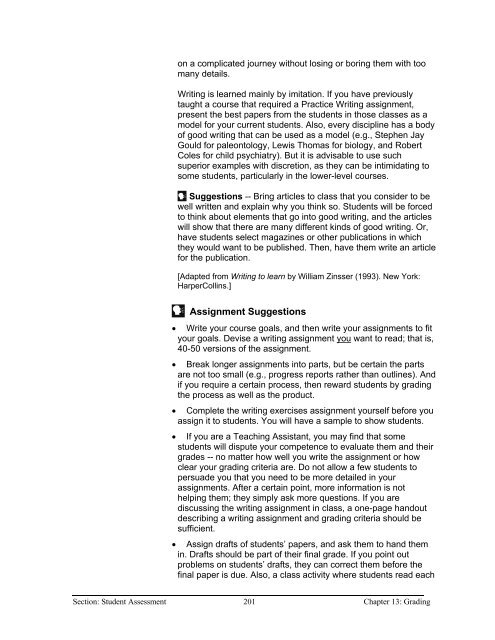Chapter 9 - Instructional Media: Chalkboards to Video - CGISS
Chapter 9 - Instructional Media: Chalkboards to Video - CGISS
Chapter 9 - Instructional Media: Chalkboards to Video - CGISS
Create successful ePaper yourself
Turn your PDF publications into a flip-book with our unique Google optimized e-Paper software.
on a complicated journey without losing or boring them with <strong>to</strong>o<br />
many details.<br />
Writing is learned mainly by imitation. If you have previously<br />
taught a course that required a Practice Writing assignment,<br />
present the best papers from the students in those classes as a<br />
model for your current students. Also, every discipline has a body<br />
of good writing that can be used as a model (e.g., Stephen Jay<br />
Gould for paleon<strong>to</strong>logy, Lewis Thomas for biology, and Robert<br />
Coles for child psychiatry). But it is advisable <strong>to</strong> use such<br />
superior examples with discretion, as they can be intimidating <strong>to</strong><br />
some students, particularly in the lower-level courses.<br />
Suggestions -- Bring articles <strong>to</strong> class that you consider <strong>to</strong> be<br />
well written and explain why you think so. Students will be forced<br />
<strong>to</strong> think about elements that go in<strong>to</strong> good writing, and the articles<br />
will show that there are many different kinds of good writing. Or,<br />
have students select magazines or other publications in which<br />
they would want <strong>to</strong> be published. Then, have them write an article<br />
for the publication.<br />
[Adapted from Writing <strong>to</strong> learn by William Zinsser (1993). New York:<br />
HarperCollins.]<br />
Assignment Suggestions<br />
• Write your course goals, and then write your assignments <strong>to</strong> fit<br />
your goals. Devise a writing assignment you want <strong>to</strong> read; that is,<br />
40-50 versions of the assignment.<br />
• Break longer assignments in<strong>to</strong> parts, but be certain the parts<br />
are not <strong>to</strong>o small (e.g., progress reports rather than outlines). And<br />
if you require a certain process, then reward students by grading<br />
the process as well as the product.<br />
• Complete the writing exercises assignment yourself before you<br />
assign it <strong>to</strong> students. You will have a sample <strong>to</strong> show students.<br />
• If you are a Teaching Assistant, you may find that some<br />
students will dispute your competence <strong>to</strong> evaluate them and their<br />
grades -- no matter how well you write the assignment or how<br />
clear your grading criteria are. Do not allow a few students <strong>to</strong><br />
persuade you that you need <strong>to</strong> be more detailed in your<br />
assignments. After a certain point, more information is not<br />
helping them; they simply ask more questions. If you are<br />
discussing the writing assignment in class, a one-page handout<br />
describing a writing assignment and grading criteria should be<br />
sufficient.<br />
• Assign drafts of students’ papers, and ask them <strong>to</strong> hand them<br />
in. Drafts should be part of their final grade. If you point out<br />
problems on students’ drafts, they can correct them before the<br />
final paper is due. Also, a class activity where students read each<br />
Section: Student Assessment 201 <strong>Chapter</strong> 13: Grading
















